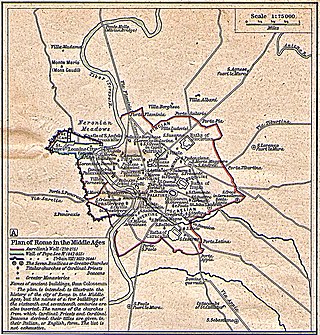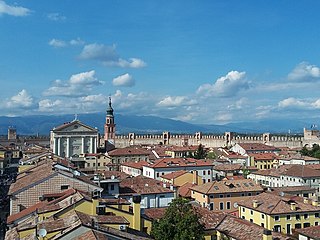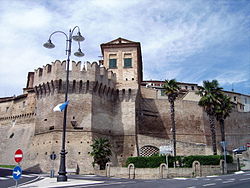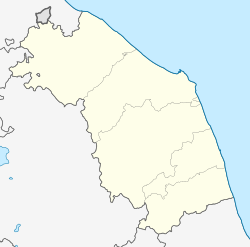
Lecce is a city in southern Italy and capital of the province of Lecce, with the second-highest population in the Apulia region. It is on the Salentine Peninsula, at the heel of the Italian Peninsula, and is over two thousand years old.

Fano is a town and comune of the province of Pesaro and Urbino in the Marche region of Italy. It is a beach resort 12 kilometres southeast of Pesaro, located where the Via Flaminia reaches the Adriatic Sea. It is the third city in the region by population after Ancona and Pesaro.

Iesi is a comune (municipality) in the province of Ancona, in the Italian region of Marche.

Terracina is an Italian city and comune of the province of Latina, located on the coast 56 km (35 mi) southeast of Rome on the Via Appia. The site has been continuously occupied since antiquity.

The Leonine City is the part of the city of Rome which, during the Middle Ages, was enclosed with the Leonine Wall, built by order of Pope Leo IV in the 9th century.

Ferentino is a town and comune in Italy, in the province of Frosinone, Lazio, 65 kilometres (40 mi) southeast of Rome. It is situated on a hill 400 metres above sea level, in the Monti Ernici area.

The Aurelian Walls are a line of city walls built between 271 AD and 275 AD in Rome, Italy, during the reign of the Roman Emperor Aurelian. They superseded the earlier Servian Wall built during the 4th century BC.

The Castello Sforzesco is a medieval fortification located in Milan, Northern Italy. It was built in the 15th century by Francesco Sforza, Duke of Milan, on the remnants of a 14th-century fortification. Later renovated and enlarged, in the 16th and 17th centuries it was one of the largest citadels in Europe. Extensively rebuilt by Luca Beltrami in 1891–1905, it now houses several of the city's museums and art collections.

Cittadella is a medieval walled city in the province of Padua, northern Italy, founded in the 13th century as a military outpost of Padua. The surrounding wall has been restored and is 1,461 metres (4,793 ft) in circumference with a diameter of around 450 metres (1,480 ft). There are four gates which roughly correspond the points of the compass.

Monterubbiano is a town and comune in the Province of Fermo, in the Marche region of Italy. It is on a hill 8 kilometres (5 mi) from the Adriatic Sea.

Urbania is a comune (municipality) in the Province of Pesaro e Urbino in the Italian region of Marche, located about 80 kilometres (50 mi) west of Ancona and about 40 kilometres (25 mi) southwest of Pesaro, next to the river Metauro.

Belforte del Chienti is a comune (municipality) in the province of Macerata in the Italian region Marche, located about 80 kilometres (50 mi) south of Ancona and about 50 kilometres (31 mi) southeast of Macerata.

Civitanova Marche is a comune (municipality) in the Province of Macerata in the Italian region Marche, located about 40 kilometres southeast of Ancona and about 25 km (16 mi) east of Macerata.

San Ginesio is a comune (municipality) in the Province of Macerata in the Italian region Marche, located about 60 kilometres (37 mi) southwest of Ancona and about 25 kilometres (16 mi) southwest of Macerata. As of December 31, 2004, it had a population of 3,872 and an area of 77.7 square kilometres (30.0 sq mi).

Capranica is a comune (municipality) in the Province of Viterbo in the Italian region Lazio, located about 55 kilometres (34 mi) northwest of GRA, 66 kilometres (41 mi) from Rome’s centre, and 24.5 kilometres (15.2 mi) southeast of Viterbo.

Porta Sempione is a city gate of Milan, Italy. The name is used both to refer to the gate proper and to the surrounding district (quartiere), a part of the Zone 1 division, including the major avenue of Corso Sempione. The gate is marked by a landmark triumphal arch called Arco della Pace, dating back to the 19th century, although its origins can be traced back to a gate of the Roman walls of Milan.

Piazza d'Aracoeli is a square of Rome (Italy), placed at the base of the Capitoline Hill, in the Rione X Campitelli.

The Museo delle Mura is an archaeological museum in Rome, Italy. It is housed in the first and second floors of the Porta San Sebastiano at the beginning of the Appian Way. It provides an exhibition on the walls of Rome and their building techniques, as well as the opportunity to walk along the inside of one of the best-preserved stretches of the Aurelian Wall. The museum is free of charge.
The following is a timeline of the history of the city of Perugia in the Umbria region of Italy.
The following is a timeline of the history of the city of Ancona in the Marche region of Italy.






















